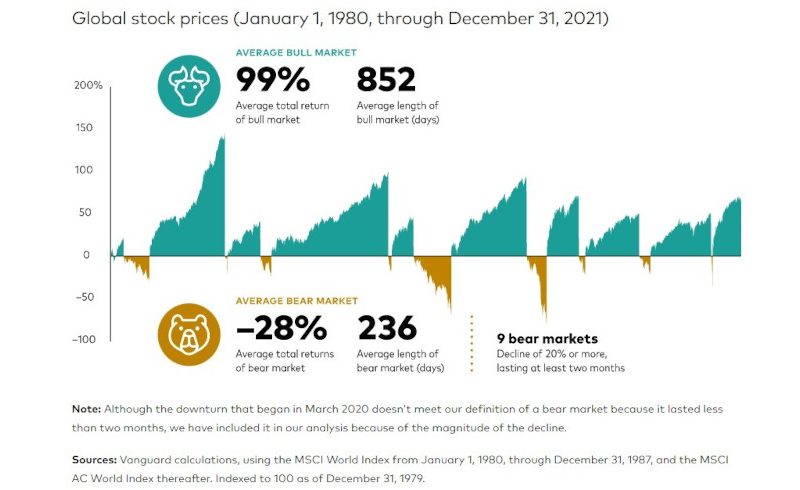
Looking back to 2022, interest rates started the year at their previous historically low levels, but as inflation was on the rise and the war in Ukraine fuelled these further, central banks around the world increased their base rates. The Bank of England base rate started the year at 0.25% and ended the year at 3.5%. The Federal Reserve’s Federal Funds Rate started at 0% to 0.25% and ended the year at 4.25% to 4.50%.
Following the rate increases, UK consumer confidence is being recorded at record lows which can often push through into low market confidence. Is this low confidence justified?
The above chart shows all years from 1980–2021, highlighting the Bull and Bear markets throughout these years. As you can see the total number of Bull years and the average Bull period is far greater than the Bear years. Following each Bear market, we can see the recovery and growth that has occurred. Nothing from 2022 suggests this would be any different, however, that is not to say that we are at the end of the Bear market.
This also presents an investment opportunity for investors who have capital to place for the medium to long term. Whilst this goes against typical emotional and psychological attitudes, the evidence shows that investing into the market when it is low, typically increases returns as it can benefit from the likely Bull to come without having had the fall from the Bear.
So how has 2023 started?
Well, people may have seen headlines that the FTSE100 stock market passed through the 8,000 level for the first time earlier in February. The FTSE All Share is up around 6% since the start of the year and the S&P500 is up 4.2% over the same period. However, inflation looks set to be a key issue again this year.
The year started positively, with inflation figures coming in below expectations, in both the UK and US. Markets reacted positively to the news, as it was thought, with inflation seemingly coming down, this may result in a lower interest rate rises in 2023, than predicted.
However, this was short-lived, as inflation data at the end of February in the US has resulted in the biggest weekly loss for 2 months in the S&P500. This has also reaffirmed the Federal Reserve’s previous position – that interest rates will be higher for longer. And now the market seems to be listening to this, with the data now backing-up this statement.
What this does show, is just how sensitive the market is at present.
What should investors do? Well, as ever, being disciplined and remaining invested in a well-diversified portfolio will benefit investors and help the longer term trends and returns come through. As we always say, it’s the time spent ‘in the market’, rather than trying to ‘time the market’ that counts.